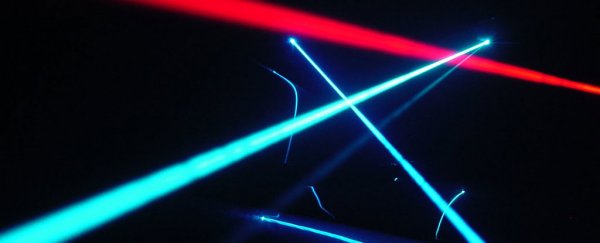A team of researchers from the Institute of Applied Physics of the Russian Academy of Sciences (IAP RAS) has just announced that they managed to calculate how to create matter and antimatter using lasers.
This means that, by focusing high-powered laser pulses, we might soon be able to create matter and antimatter using light.
To break this down a bit, light is made of high-energy photons. When high-energy photons go through strong electric fields, they lose enough radiation that they become gamma rays and create electron-positron pairs, thus creating a new state of matter.
"A strong electric field can, generally speaking, 'boil the vacuum,' which is full of 'virtual particles,' such as electron-positron pairs. The field can convert these types of particles from a virtual state, in which the particles aren't directly observable, to a real one," says Igor Kostyukov of IAP RAS, who references their calculations on the concept of quantum electrodynamics (QED).
 NASA Astrophysics
NASA Astrophysics
A QED cascade is a series of processes that starts with electrons and positrons accelerating within a laser field. It will then be followed by the release of high-energy photons, electrons, and positrons.
As high-energy photons decay, it will produce electron-positron pairs. Essentially, a QED cascade will lead to the production of electron positron high-energy photon plasmas – and while it perfectly illustrates the QED phenomenon, it is a theory that has yet to be observed under lab conditions.
Based on this, researchers observed how intense laser pulses would interact with a foil via numerical simulations. Surprisingly, they discovered that there were more high-energy photons produced by the positrons versus electrons produced of the foil.
And if you could produce a massive number of positrons via a corresponding experiment, you can conclude that most were generated via a QED cascade.
As complicated as all that sounds, here's the bottom line – this discovery can open new doors in terms of how we can efficiently and cost-effectively produce matter and antimatter, the latter of which can significantly change the way we power our spaceships.
As has been previously noted, making this potential power source is not cheap:
"The problem lies in the efficiency and cost of antimatter production and storage. Making 1 gram of antimatter would require approximately 25 million billion kilowatt-hours of energy and cost over a million billion dollars."
This work offers us a new way forward.
Their study also offers major insight into the properties of different types of interactions that could eventually pave the way for practical applications, including the development of advanced ideas for the laser-plasma sources of high-energy photons and positrons that will exceed the brilliance of any available source we have today.
"Next, we're exploring the nonlinear stage when the self-generated electron-positron plasma strongly modifies the interaction," the researchers add.
"And we'll also try to expand our results to more general configurations of the laser-matter interactions and other regimes of interactions – taking a wider range of parameters into consideration."
This article was originally published by Futurism. Read the original article.
